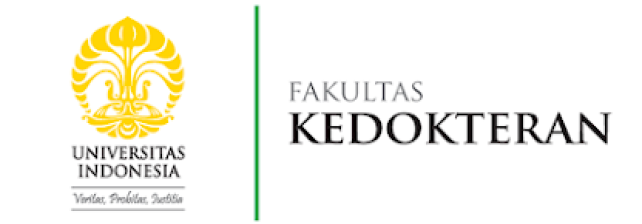Aside from medical studies, FKUI also support the arts and heritage. FKUI has a lot of events that goes in the theme of art, this includes; Unjuk Rasa and Satu Untuk Semua, a big art event that showcases the FKUI’s community talents in musical drama, orchestra and others. The student council of FKUI has its own arts departement where they held extracuricurral activities for specific arts for their students. Under the student council there is a specific organization for film and photo enthousiasts called BFM (Badan Film Mahasiswa), where they also held film screenings and art exhibitions. Students of FKUI has also won and/or compete ini non-medical competitions such as Abang None and Miss Indonesia. The student council of FKUI also conducted a work program “Contingent Guidance” where they guide and support art contingents to compete in UIAW, medical league, and national other art competitions.
The historic white building of FKUI has been conserved as an iconic landmark in DKI Jakarta as a cultural heritage which was built since 1916-1920. FMUI allocated budgets in for building maintenance and conservations each year in order to preserve the national cultural heritage building. In 2020, as commemoration of the 100th anniversary of the building, FKUI carried out a series of activities to preserve the FKUI building as a cultural heritage building in the form of building renovations and environmental preservation of cultural heritage buildings. Also, inside IMERI FKUI there is a museum that has been officialized by the government. The museum comprises of more than 5000 collections of medical specimens and artefacts as well can be helpful for students’ learning process. This museum has also won an award for the smart museum category. iMuseum is open for public and during the pandemic, iMuseum conducted virtual tour.
11.2.2 Public Access to Libraries
Provide public access to libraries including books and publications
•With free access
•Paid Access
Maintaining integrity as the oldest faculty in Indonesia, the largest producer of medical graduates in the entire country, FKUI provides a library as a means of learning as well as a place to develop knowledge. Collaborating with the IMERI Knowledge Management Center Cluster since 2017, the FKUI Library continues to innovate on the basis of technology and information to make the Faculty Library superior and apply the values: service excellent, comprehensive, user friendly, current, and collaboration. UI academics, both the Faculty of Medicine and other faculties, have access to Digilib Library, which is located on the 10th floor of IMERI FKUI
11.2.3 Public access to Museums
Provide public access to museums, exhibition spaces or galleries, or works of art and artefacts
•With free access
•Paid access
Universitas Indonesia has provided public access to iMeri (Indonesia Museum of Health and Medicine (iMuseum) IMERI FMUI at UI Campus Salemba Jakarta. Indonesia Museum of Health and Medicine (iMuseum) IMERI FKUI was inaugurated on September 14th, 2017. It is located in Salemba Raya St. No. 6, Kenari, Senen, Central Jakarta. This museum has over 5,000 collections mainly the legacy of the Dutch colonial era, when the Faculty of Medicine UI was still known as School tot Opleiding van Indische Artsen (STOVIA). These collections are medical specimens and artefacts in the form of medical devices, videos, and media directories. The museum has the first and only modern media machines in South East Asia, which can now be seen live at iMuseum IMERI FKUI. With technological advancements and 3D human body visualization, medical students can execute internal surgeries on a three-dimensional imaging of a human anatomy. During the pandemic, iMuseum provided adaptive solution for open access touring for the citizens through the program called “Belajar Kedokteran dan Kesehatan bersama iMuseum IMERI (ARTERI)” that was conducted online for elementary students across Indonesia.
11.2.4 Public Access to Green Spaces
- Site Management (Pengelolaan Tapak).
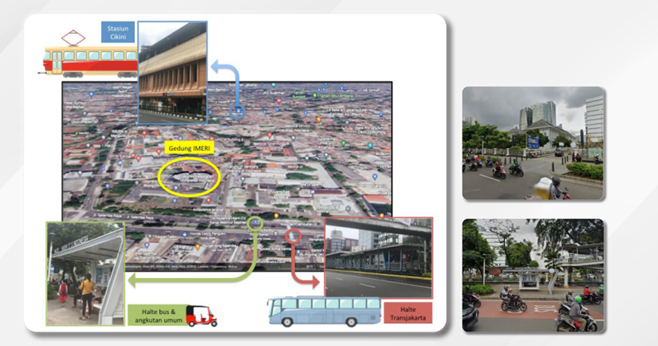
- The FKUI building, located in the Salemba and Pegangsaan Timur campus area, is easily accessible by public transportation. Its strategic position near the RSCM busway stop on Jl. Diponegoro and the UI busway stop on Jl. Salemba Raya facilitates various transport options, including Transjakarta, Jaklingko, mikrolet, bajaj, and other public vehicles. The commuter line is also reachable from Cikini train station, which is a short walk away. Most of the FKUI population uses available public transport, resulting in fewer vehicles around the faculty compared to daily foot traffic. The busway stop is approximately 200 meters away, while Cikini station is about 1.2 kilometers from FKUI, making it more environmentally friendly and efficient by reducing travel time and avoiding traffic congestion.
- Pedestrian pathways are available and integrated with main road walkways, including dedicated routes for individuals with disabilities that connect directly to Gedung H.

- Examples of Green Open Spaces
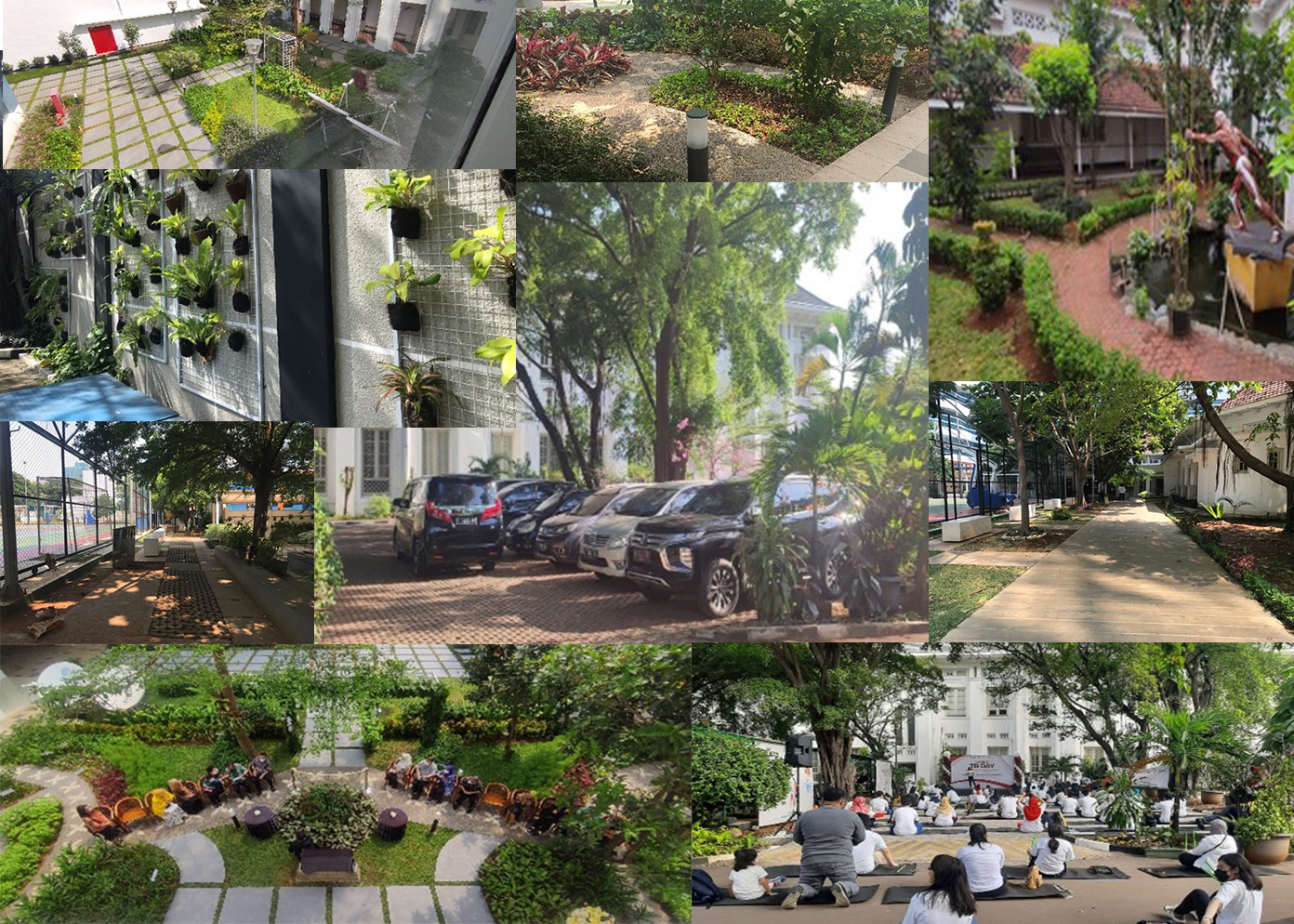
- Inauguration of the Park (Peresmian Taman)
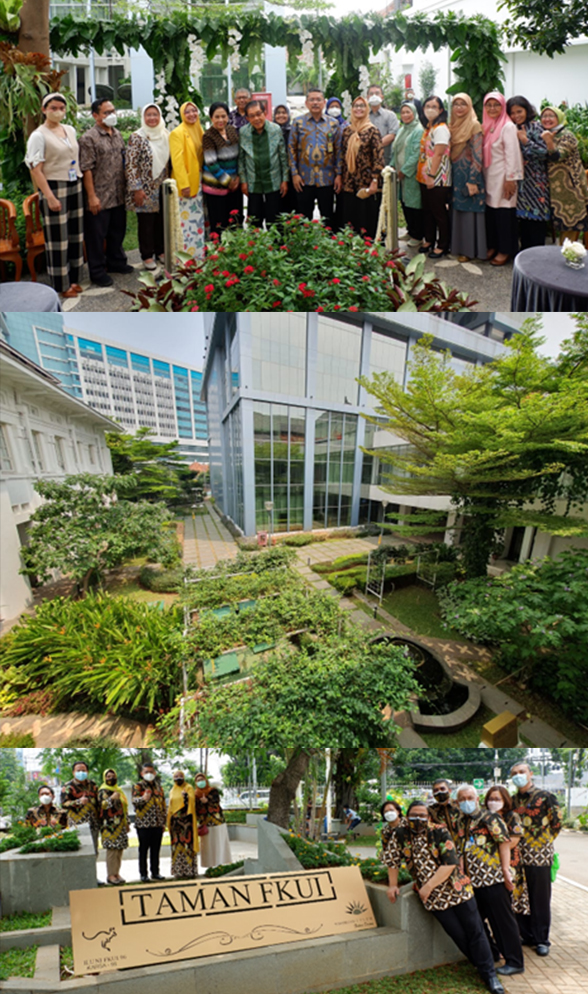
- Inauguration of Taman Anggrek (Peresmian Taman Anggrek)
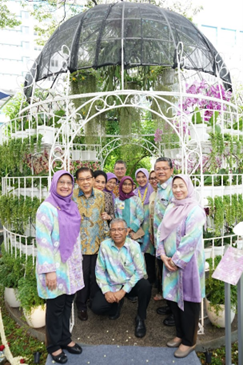
11.2.5 Arts and heritage contribution
Contribute to local arts, in terms of number of annual public performances of university choirs, theatre groups, orchestras etc. Either ad-hoc or as part of an ongoing programme.
In order to foster artistic creativity of students at FMUI, Student Executive Board (BEM FMUI) established the Department of Art that has artistic activities such as dance, choir, music, and photography seminars. The art activities that BEM FMUI regularly holds were:
Cultural Arts Activities of FKUI
11.2.6 Record and Preserve Cultural Heritage
In the realm of cultural arts, one of the pride of Universitas Indonesia is the FKUI Building. This building is a cultural heritage site in DKI Jakarta, featuring European-style architecture constructed between 1916-1920. Initially, it served as GHS (higher medical school) to replace STOVIA. During the Japanese occupation, it continued to function as a medical school known as Ika Dai Gaku. After independence, it became the Balai Perguruan Tinggi Republik Indonesia (BPTRI) and later Universiteit van Indonesia. Alumni of this institution became prominent figures in the national movement, opposing Japanese authority and fighting for Indonesia's independence during the physical revolution. Given its historical significance and architectural value, the FKUI building, located at Jl. Salemba Raya No. 6, and the Microbiology Building at Jl. Pegangsaan Timur No. 16, deserve special attention from the government for preservation as a Cultural Heritage Site based on:
- Keputusan Menteri Pendidikan dan Kebudayaan Republik Indonesia No. 0128/M/1988 Tentang Penetapan beberapa Gedung, Museum, masjid dan Gereja Sebagai Cagar Budaya yang dilindungi Monumenten Ordonnantie Staatsblad Nomor 238 Tahun 1931.
- Keputusan Gubernur Kepala Daerah Khusus Ibukota Jakarta Nomor: 475 tahun 1993 Tentang Penetapan Bangunan-bangunan Bersejarah di Daerah Khusus Ibukota Jakarta sebagai Benda Cagar Budaya.
Based on the designation of the Faculty of Medicine building at Universitas Indonesia as a Cultural Heritage Site, any renovation, alteration, color change, replacement of building elements, relocation, dismantling, or separation of parts of the building must first consult and obtain recommendations from the Tourism and Culture Office of the Special Capital Region of Jakarta.
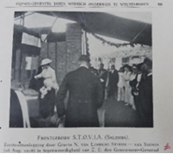
Gambar 1. Peletakan batu pertama secara resmi dari Bangunan Utama Gedung Fakultas Kedokteran UI dilakukan oleh Nyonya van Limburg Stirrum van Sminia pada tanggal 26 Agustus 1916 di depan Paduka Gubernur Jendral.

Gambar 2. Batu pertama yang diletakkan oleh Nyonya van Limburg Stirrum van Sminia.
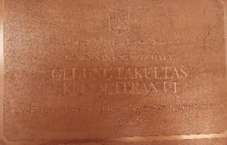
Gambar 3. Penetapan sebagai benda cagar budaya.
This building, architecturally styled in Dutch, is characterized by high ceilings for air circulation. It is symmetrically sized and, when viewed from above, resembles the letter H, which is why it is sometimes referred to as Gedung H. Salemba 6 is generally white, a distinguishing feature indicating its use for the interests of the Dutch East Indies, making it exempt from attacks. The building has been preserved as a place for education and research for FKUI, although some classes are held at the Depok UI campus, and it is also one of the protected cultural heritage sites in Jakarta.
In the FKUI lobby, there is a plaque commemorating Dr. J. Noordhoek Hegt, who was the proponent for the construction of the new STOVIA building, but he passed away before it was completed.

The plaque states that:
- J. Noordhoek Hegt was born in Batavia on March 10, 1868, and passed away in The Hague on September 30, 1915.
- He served as the Director of STOVIA from November 9, 1908, until February 28, 1915.
- This plaque was inaugurated by the Head Inspector of Medical Services.
- The bottom part reads: "For he who has shown great initiative and dedication to the construction of this educational building (in this case, Gedung Salemba 6), which began operation on July 5, 1920. Our thanks to him.”
- On the right and left sides, there are common symbols in the field of medicine and health, namely the staff entwined with a serpent, known as the Staff of Aesculapius.
On July 5, 1920, the medical education building at Salemba 6 was completed, and all educational facilities were moved there. To commemorate the 100th anniversary of the building, FKUI organized a series of preservation activities, including renovations and environmental conservation of the cultural heritage site. This involved the return of the plaque for the groundbreaking (peletakan batu pertama) of the Main Building, conducted by Mrs. van Limburg Stirrum van Sminia on August 26, 1916, in front of His Excellency the Governor-General. The plaque's return was carried out by FKUI alumni from the class of 1996, coinciding with FKUI's 71st anniversary on February 24, 2021, marked by the unveiling of the plaque by the Dean of FKUI and the Chair of the 1996 alumni.
III. Indonesia Museum of Health and Medicine (IMuseum) IMERI FKUI
Within the FKUI complex, there is the Indonesia Museum of Health and Medicine (IMuseum) IMERI FKUI, inaugurated on September 14, 2017, by the Coordinating Minister for Human Development and Culture of Indonesia from 2014 to 2019, Puan Maharani. The IMuseum not only covers the history of medical education in Indonesia but also provides information and education to the public about health and medicine, presented through the theme of the human life cycle from conception to old age.
The IMuseum IMERI FKUI houses over 5,000 collections, including medical specimens and artifacts related to medical education, videos, media directories, and historical photos. These collections are distributed across six areas: Medical Education Journey in Indonesia, Health Education Area, Medical Collection Area, Lobby, Edutainment Area, and Showcase.
Additionally, IMuseum IMERI FKUI provides educational support facilities for health and medical communities, featuring health specimen collections from the Dutch East Indies era to the modern age. The museum is made even more engaging with the inclusion of a 3D human body visualization table, which enhances the learning process in medical education by allowing for clear and easy exploration of human anatomy in three dimensions.
On October 13, 2019, IMuseum IMERI FKUI received the Anugerah Purwakalagrha Indonesia Museum Awards 2019 in the Smart Museum category. In this category, IMuseum IMERI FKUI was recognized alongside four other nominees: Biofarma Museum, Bank Indonesia Museum, Indonesia Islamic Art Museum, and Pavilion 5 Museum. The evaluation criteria for this category included the ability to provide context, information, and knowledge that evolves in line with changing times.
In its management, IMuseum IMERI FKUI continuously strives to improve services and quality to attract public interest in visiting. In the future, the museum aims not only to preserve historical artifacts of medical education but also to actively enhance the quality of health and medical education in Indonesia and provide ongoing health information and medical education to both health communities and the general public. Activities at IMuseum IMERI FKUI are reported annually.
